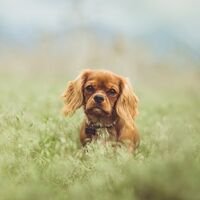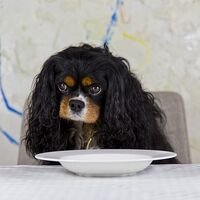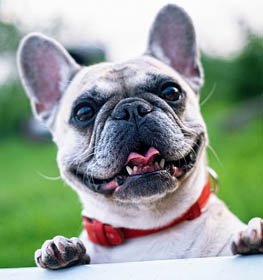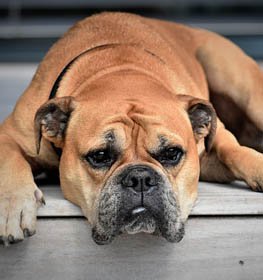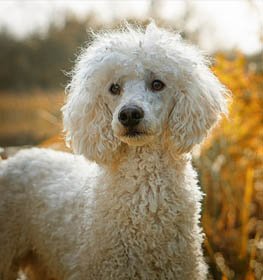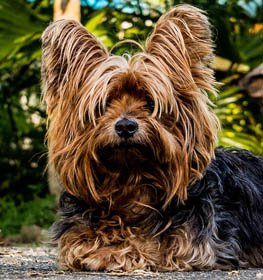Cavalier King Charles Spaniel Information & Dog Breed Facts
Collection of all the general dog breed info about Cavalier King Charles Spaniel so you can get to know the breed more.
| Group | Companion Dogs |
|---|---|
| Popularity Rank | 19 |
| Reviews | 7 |
| User Ratings | |
|
Compare the Cavalier King Charles Spaniel With Other Dogs
Select at least one dog breed to make the comparsion. | |
 | |
| Origin | |
|
Common Names & Aliases
What other names is a Cavalier King Charles Spaniel known by? Discover all traditional, regional and informal names used for this breed. | CavalierCavieCav |
|---|---|
|
Breed Classification
What type of dog breed is a Cavalier King Charles Spaniel? Learn about its genetic classification and breeding category. | Purebred The Cavalier is considered a purebred dog breed, but many mixes and hybrids have been created from this breed. We have compiled a list of Cavalier King Charles Spaniel Mixes. |
Overview
Photo Gallery of the Cavalier King Charles Spaniel Breed
|
Size Classification
What size category is a Cavalier King Charles Spaniel? Learn how big the Cavalier King Charles Spaniel breed typically grows. | Small |
|---|---|
|
Weight Statistics
How much does a Cavalier King Charles Spaniel weigh? Discover typical weight ranges for adult males and females of the Cavalier King Charles Spaniel breed. | 10-18 pounds (5-8 kg) |
|
Average Weight
What is the average weight of a Cavalier King Charles Spaniel? | 14 pounds (6.5 kg) |
|
Height
How tall is the Cavalier King Charles Spaniel? Cavalier King Charles Spaniel height: | 12-13 inches (30-33 cm) |
|
Average Height
What is the average height of a Cavalier King Charles Spaniel? | 12.5 inches (31.5 cm) |
|
Price Range
How much does a Cavalier King Charles Spaniel puppy cost? Find current market prices and factors affecting Cavalier King Charles Spaniel costs. | $1200-$1500 If you choose to purchase the Cavalier King Charles Spaniel, you should know that the mentioned amount of money is an average of the collected data from breeders’ sites and puppy finder places. If you have a Cavalier King Charles Spaniel for sale, please advertise it on a reliable website to make sure the Cavalier King Charles Spaniel gets to a happy place. |
|---|---|
|
Availability
How easy is it to get a Cavalier King Charles Spaniel? How many Cavalier King Charles Spaniel are there in the world? | Very frequent: The Cavalier King Charles Spaniel is quite easy to get. There is a risk of overbreeding, as it is an extremely popular breed. Inbreeding is common because of its popularity. A new study suggests that inbreeding contributes to the incidence of disease and health problems. So be careful, buy from a trustworthy place or kennel and seek the help of an experienced person, a professional, to make the right decision. |
|
Intelligence Rating
How intelligent is a Cavalier King Charles Spaniel? Discover the Cavalier King Charles Spaniel's intelligence ranking and learning capabilities. | Average: It takes patience to teach this breed any tricks or commands, but the effort is worth it. They understand and remember new commands after an average of 25-40 repetitions.
The Cavalier King Charles Spaniel ranks average in the intelligence ranking of dogs. |
|---|---|
|
Training Difficulty
How easy is it to train a Cavalier King Charles Spaniel? Learn about the Cavalier King Charles Spaniel's trainability and response to training methods. | Cavalier King Charles Spaniel dogs are quite easy to train. Sometimes they can be challenging, but if you're consistent in teaching new commands they will obey for sure. |
|
Watchdog Rating
How good is a Cavalier King Charles Spaniel as a watchdog? Learn about the Cavalier King Charles Spaniel's alertness and guarding instincts. | Cavalier King Charles Spaniel dogs are not the best watchdogs. They aren't very territorial and protective about their property, so they probably won't alert you if they sense something different. |
|
Territorial Protection
Is a Cavalier King Charles Spaniel protective of its territory? Learn about the Cavalier King Charles Spaniel's guarding instincts and behavior. | Cavalier King Charles Spaniel dogs are not the best to protect their territory. Better to have the protection of your house and property supervised by others. |
|
Personality Traits
What personality does a Cavalier King Charles Spaniel have? Learn about characteristic Cavalier King Charles Spaniel temperament and behavior traits. | ActiveCourageousIntelligentFriendlyAffectionateGentleSocialFearlessCheerfulQuietNonaggressivePoliteGracefulSportyNo tendency towards nervousness |
|---|---|
|
Sensitivity Level
How sensitive are they? Cavalier King Charles Spaniel sensitivity: | Sensitive: Cavalier King Charles Spaniel dogs don't like an irregular daily routine, noisy household, and frequent guest visits.
This breed's emotional level reflects their owner's feelings and they don't handle punishments well. |
|
Affection Level
How affectionate are they? Is a Cavalier King Charles Spaniel a good family dog? | High: Cavalier King Charles Spaniel dogs are genuinely loyal, soft and gentle, loving, and affectionate dogs toward their handlers. They enjoy quality time with their owners despite the activity and are considered great therapy dogs for those in need. This breed responds strongly to their handler's emotions because they bond closely. Their happiness is your happiness. |
|
Social Needs
How much social interaction does the Cavalier need? Cavalier King Charles Spaniel social needs: | Cavalier King Charles Spaniel dogs need a lot of social interaction. They desire to always be with someone or around people. This breed hates being left alone. |
|
Impulse to Wander or Roam
How likely is the Cavalier King Charles Spaniel to run away? Does this breed explore or wander a lot? Does Cavalier King Charles Spaniel roam? | Cavalier King Charles Spaniel dogs tend to escape less than other breeds. They have low to average wanderlust potential. Exploring the world is not the best activity they can imagine. |
|
Prey Drive
Do this canine have a strong prey drive? Does Cavalier King Charles Spaniel have high prey drive? | Cavalier King Charles Spaniel dogs have an average prey drive, which means that they don't have a high impulse to chase and catch something like a cat or any other small aminals, but it might happen. Training can help to achieve good behavior. |
|
Barking Frequency
Does a Cavalier King Charles Spaniel bark a lot? Learn about typical Cavalier King Charles Spaniel vocalization patterns and triggers. | Average: The Cavalier King Charles Spaniel barks occasionally. They can change their barks depending on their emotional level and what they're trying to say. Different barks could mean the same and the same barks could have different meanings.
Top reasons for barking: protection, alarm, fear, boredom, attention-seeking, greeting, separation anxiety, compulsive barking. |
|---|---|
|
Playful Nature
How playful is a Cavalier King Charles Spaniel? Understand the typical play drive and energy level of the Cavalier King Charles Spaniel breed. | Average: Cavalier King Charles Spaniels, like any other dog breed, like playing. Sometimes they bark in excitement for playing, but they are not the most playful dog breed. |
|
Apartment Adaptability
Can a Cavalier King Charles Spaniel live in an apartment? Learn about the Cavalier King Charles Spaniel's suitability for apartment living. | Very house-friendly dog the Cavalier King Charles Spaniel breed. It's good if you have a small garden where he can go out and do his business, but it's not important at all. You can get enough exercise with one or two walks a day, so keeping them indoors shouldn't be a problem. |
|
Lifestyle Adaptability
How adaptable is a Cavalier King Charles Spaniel to lifestyle changes? Learn about the Cavalier King Charles Spaniel's flexibility to new situations. | Cavalier King Charles Spaniel dogs adapt very well to lifestyle changes and basically all living environments. They don't mind moving from one place to another with their owner. |
|---|---|
|
Alone Time Tolerance
Can a Cavalier King Charles Spaniel be left alone? Learn about the Cavalier King Charles Spaniel's tolerance to solitude. | Cavalier King Charles Spaniel dogs tend to have separation anxiety when their owners left them alone at home because they bond very closely with them. |
|
Bite Risk Assessment
What is a Cavalier King Charles Spaniel biting potential? Learn about the Cavalier King Charles Spaniel's bite risk factors. | Low 🔽 The Cavalier King Charles Spaniel has a low chance of biting somebody. Top reasons for dog bite: protection, pain, excitement, herding instinct, being provoked. (Data based on the available online bite statistics.) |
|---|---|
|
Mouthing Tendency
Is a Cavalier King Charles Spaniel mouthy? Learn about the Cavalier King Charles Spaniel's tendency to use mouth during play. | Cavalier King Charles Spaniel dogs have an average tendency to nip, chew, playbite, or herd people. It's a common habit during puppyhood, not aggressive behavior. These "bites" don't hurt, but Cavalier King Charles Spaniel dogs need to be taught a good attitude. |
|
Bite Strength Rating
How strong is a Cavalier King Charles Spaniel bite? Learn about the Cavalier King Charles Spaniel's bite force measured in PSI. | Between 100 and 200 PSI 🔽 Cavalier King Charles Spaniel bite force: Weak. The Cavalier King Charles Spaniel bite force is considered weak when compared to other dog breeds. The bite force Cavalier King Charles Spaniel measurements usually fall below 200 PSI, making them one of the breeds with the weakest bite force. The bite force of a Cavalier King Charles Spaniel may be weak, but it's important to remember that any dog's bite can still be dangerous if not managed properly. Despite the bite force of Cavalier King Charles Spaniel being lower, it does not make them any less lovable or enjoyable as pets.
Cavalier King Charles Spaniel bite wounds might not be as severe, but it is still essential to be cautious and prevent any biting incidents. They are usually not aggressive and very friendly towards children and other animals. To ensure a well-behaved dog, it's essential to learn how to train a Cavalier King Charles Spaniel puppy not to bite from an early age. With proper training and socialization, a Cavalier King Charles Spaniel can be a wonderful addition to any family, providing love and companionship for years to come. |
|
Average Lifespan
How long does a Cavalier King Charles Spaniel live? Learn about the typical lifespan of the Cavalier King Charles Spaniel breed. | 10-14 years The average lifespan of Cavalier King Charles Spaniel: 12 years |
|---|---|
|
Climate Tolerance
How well does a Cavalier King Charles Spaniel handle different weather? Learn about the Cavalier King Charles Spaniel's climate adaptability. | Tolerates warm and cold weather Dogs that tolerate hot and cold weather are typically those that have a double coat of fur. Dogs with a double coat of fur have a layer of fur that insulates their skin and helps protect them from the cold and the heat. |
|
Health Concerns
What health issues are common in a Cavalier King Charles Spaniel? Discover typical conditions affecting the Cavalier King Charles Spaniel breed. | Cavalier King Charles Spaniels tend to have more frequent health issues than other breeds. Regular vet check-ups are needed.
|
|
Vet Care Frequency
How often does a Cavalier King Charles Spaniel need vet visits? Learn about the Cavalier King Charles Spaniel's veterinary care requirements. | Frequent The Cavalier King Charles Spaniel should have a complete physical check-up at least once (but preferably twice) per year. If your dog shows any symptoms, call your veterinarian. |
|
Health Problems
What genetic/health problems does the Cavalier King Charles Spaniel breed have? What are the health issues and concerns of the Cavalier King Charles Spaniel breed? Most common health risks of Cavalier King Charles Spaniel: | Hip Dysplasia Patellar LuxationMitral Valve DiseaseDry EyeEpisodic Falling SyndromeSyringomyelia |
|
Energy Rating
How energetic is a Cavalier King Charles Spaniel? Understand daily activity needs of the Cavalier King Charles Spaniel breed. | Cavalier King Charles Spaniel dogs have an average energy level, so if you live a semi-active life, this breed can be a good choice for you. |
|---|---|
|
Activity Requirement / Exercise Need
How much exercise does a Cavalier King Charles Spaniel need? How much exercise do Cavalier King Charles Spaniel dogs require per day?
Do Cavalier King Charles Spaniel dogs need a lot of exercises? | Cavalier King Charles Spaniel dogs have an average exercise need. This breed is satisfied with short walks every weekday and a long ones on weekends. |
|
Sleeping Need
How much sleep does the Cavalier King Charles Spaniel breed need? | Cavalier King Charles Spaniel dogs sleep 12-14 hours a day as an average dog and they're not considered a lazy breed. |
|
Obesity Tendency
Is a Cavalier King Charles Spaniel prone to weight gain? Learn about the Cavalier King Charles Spaniel's obesity risks. | Average to High: If you don't pay attention to the Cavalier King Charles Spaniel's weight, he can easily gain weight. More than one daily walk should be on schedule. To make your dog happy and fit, feed him with quality dry dog food and live an active life together. Try to find the happy medium between exercise and feeding.
If you notice any weight gain, consult your veterinarian and make a diet plan. Reduce unhealthy food and snacks, and measure the Cavalier King Charles Spaniel weight regularly. |
|---|---|
|
Food Consumption
How much food does a Cavalier King Charles Spaniel need daily? Learn about the Cavalier King Charles Spaniel's feeding requirements. | 1 to 1.5 cups of high-quality dry food a day, divided into two meals. |
|
Allergy Friendliness
Is a Cavalier King Charles Spaniel hypoallergenic? Learn about the Cavalier King Charles Spaniel's suitability for allergy sufferers. | No Cavalier King Charles Spaniel dogs don't do well with allergy sufferers by causing allergic reactions. Some dog breeds are even considered to higher possibility of an allergic response. Coat type isn't necessarily relevant, because most people are allergic to dander (flakes on the dog's skin) or saliva, not actually to dog hair. |
|---|---|
|
Coat Colors
What colors does a Cavalier King Charles Spaniel come in? Discover all possible Cavalier King Charles Spaniel color variations. | Tan Tricolor BlenheimRuby |
|
Grooming Requirements
How much grooming does a Cavalier King Charles Spaniel need? Learn about Cavalier King Charles Spaniel coat maintenance requirements. | Average: The Cavalier King Charles Spaniel requires average grooming effort. Cutting the dog's hair by a professional groomer isn't essential. Brushing the dog's coat is useful to reduce shedding. Ears and eyes should be cleaned regularly to avoid infections. Don't skip the seasonal flea treatment too. Dog nail trimming and dog bath can be helpful sometimes. Check the local pet store for dog grooming supplies and find the best dog shampoo to keep its coat healthy and give your dog a pleasant experience of a dog bath. If you don't have the time, skill, or money to take care of your Cavalier King Charles Spaniel, search for a dog groomer or clipping service in your area and book an appointment. Maybe you're lucky to have a dog boarding service that includes grooming or walk-in dog bath places nearby. |
|
Drooling Tendency
Does a Cavalier King Charles Spaniel drool a lot? Learn about the Cavalier King Charles Spaniel's drooling habits. | The Cavalier King Charles Spaniel is a perfect example of a very low drooling tendency. If you're disgusted by slobber spots on your clothes, the Cavalier King Charles Spaniel could be a perfect choice for you. Drooling is the unintentional saliva flowing outside of the mouth. It can be completely normal or a sign of a health problem. Certain dog breeds drool minimum compared to others, just like the Cavalier King Charles Spaniel.
If you notice any change in your dog's drooling habit, you should contact a vet as soon as possible. |
|
Stinkiness Rating
Does a Cavalier King Charles Spaniel smell bad? Learn about the Cavalier King Charles Spaniel's natural odor levels. | High 🔼 The Cavalier King Charles Spaniel has a high chance of bad smell. Top reasons for dog stinkiness: infection of bad tooth/ear/skin folds, gas attacks. |
|
Coat Characteristics
What type of coat does a Cavalier King Charles Spaniel have? Learn about the Cavalier King Charles Spaniel's fur characteristics. | Feathered |
|
Bathing Needs
How often does a Cavalier King Charles Spaniel need baths? Learn about the Cavalier King Charles Spaniel's bathing requirements. | 6-8 weeks Rarely. Bathing your dog is beneficial to them in more ways than just one. It’s also a good time to look for unusual scratches, bumps, fleas, and other irregularities. When their hair is wet and flat against their body, these details are more visible.
For example, short-haired dog breeds can go a very long time in between baths. These short-haired breeds shed regularly and that shedding works to naturally remove excess dirt and oil. So unless your weenie dog got into the garbage can, you can probably hold off on a bath for a while. |
|
Shedding Level
How much do Cavalier King Charles Spaniel dogs shed? How to control, reduce and prevent the shedding of the Cavalier? Do Cavalier King Charles Spaniel dogs shed a lot? | Cavalier King Charles Spaniel dogs shed above average. It's a natural process of the hair growth cycle. The amount and frequency of hair loss mostly depend on their health status and breed type. If you don't like vacuum cleaning, you might have to reconsider your choice of having a puppy from the Cavalier King Charles Spaniel breed. |
|
Child Compatibility
Is a Cavalier King Charles Spaniel good with children? Learn about the Cavalier King Charles Spaniel's behavior around kids of different ages. | Cavalier King Charles Spaniel dogs are very kid-friendly dogs. This breed enjoys being surrounded by children.
|
|---|---|
|
Pet Compatibility
How well does a Cavalier King Charles Spaniel get along with other pets? Discover the Cavalier King Charles Spaniel's compatibility with other animals. | Cavalier King Charles Spaniel dogs are generally with other pets. |
|
Stranger Friendly
Are they aggressive or friendly towards/with strangers? Cavalier King Charles Spaniel temperament with other people: | Cavalier King Charles Spaniel dogs are very stranger-friendly dogs. |
|
Cat Friendly
How well do Cavalier King Charles Spaniel dogs get along with cats? Are they good with kittens? What is this fido's temperament with cats? Can they be good with cats? Can the Cavalier King Charles Spaniel breed live with a cat? | Cavalier King Charles Spaniel dogs are average friendly towards cats. |
|
Dog Friendly
Is Cavalier King Charles Spaniel good with other dogs? Are they dog-friendly dogs? How well do Cavalier King Charles Spaniel dogs get along with other dogs? | Cavalier King Charles Spaniel dogs are very dog-friendly dogs. If you want more dogs in your family or you'd like to join dog meetups, the Cavalier King Charles Spaniel can be a great choice. |
|
Good For First Time Owners
Is Cavalier King Charles Spaniel breed good for first-time owners? Do they make a good dog for novice owners? Is Cavalier King Charles Spaniel breed suitable for first-time owners? | Yes Cavalier King Charles Spaniel dogs are good for novice owners, due to their easy-going personality. |
|
Office Friendly
Are Cavalier King Charles Spaniel dogs good office canines? Do Cavalier King Charles Spaniel dogs make good office-friendly pets? Can they be office dogs? | No Cavalier King Charles Spaniel is not the best dog breed for office environment. |
|
Senior Citizens Friendly
Are they senior citizens friendly dogs? How well do Cavalier King Charles Spaniel dogs get along with the elderly people? What is the Cavalier temperament with senior people? Are Cavalier King Charles Spaniel dogs good for elderly owners? | Cavalier King Charles Spaniels are one of the best breeds for elderly people. |
|
Service Dog Capability
Can a Cavalier King Charles Spaniel be a service dog? Learn about the Cavalier King Charles Spaniel's service work potential. | Not really This breed generally not used as a service dog. A service dog is a term used in the USA to refer to any type of assistance dog specifically trained to help people who have disabilities, such as visual impairment, hearing impairments, mental disorders, seizures, mobility impairment, and diabetes. Service dogs are protected under the ADA (Americans with Disabilities Act).
Cavalier King Charles Spaniel is not the best breed for service purposes. |
|---|---|
|
Therapy Work Suitability
Is a Cavalier King Charles Spaniel good as a therapy dog? Learn about the Cavalier King Charles Spaniel's therapy work aptitude. | Yes This breed makes a perfect therapy dog. A therapy dog is a dog that might be trained to provide affection, comfort, and love to people in hospitals, retirement homes, nursing homes, schools, hospices, disaster areas, and people with anxiety disorders or autism.
Cavalier King Charles Spaniel breed is a good choice for therapeutic purposes. |
|
Scent Detection Ability
Is a Cavalier King Charles Spaniel good at detection work? Learn about the Cavalier King Charles Spaniel's scenting abilities. | Not really They are not typically employed for this type of work, but there may be exceptional cases. A detection dog or sniffer dog is a dog that is trained to use its senses (mostly its smell) to detect substances such as explosives, illegal drugs, wildlife scat, currency, blood, and contraband electronics such as illicit mobile phones.
Cavalier King Charles Spaniel is not the best breed for detection purposes. |
|
Search & Rescue Potential
Can a Cavalier King Charles Spaniel do search and rescue? Learn about the Cavalier King Charles Spaniel's SAR capabilities. | Not really This dog breed is not typically used as a search and rescue dog. The use of dogs in search and rescue (SAR) is a valuable component in wilderness tracking, natural disasters, mass casualty events, and locating missing people.
The Cavalier King Charles Spaniel is not the best breed for SAR purposes. |
|
Maritime Work Ability
Is a Cavalier King Charles Spaniel good on boats? Learn about the Cavalier King Charles Spaniel's maritime capabilities. | Not really Cavalier King Charles Spaniel breed usually doesn't like being on a boat. Boat dogs were typically bred for their strength, stamina, and water resistance, as they were often required to perform tasks such as pulling in fishing nets, and jumping into the water to retrieve ropes or lines, or helping to move cargo. Sailor dog is a type of dog that was bred to accompany sailors on their voyages. They were typically used for three purposes: as a working dog, a watchdog, and as a companion. A boat dog is a term used to describe a type of dog that was traditionally bred and used as a working dog on boats. |
|
Draft Work Capability
Can a Cavalier King Charles Spaniel pull carts? Learn about the Cavalier King Charles Spaniel's drafting abilities. | Not really A drafting dog or draft dog is a dog bred and used for cart pulling. Dogs bred for this work have strong builds and qualities that are needed, strength and determination.
Cavalier King Charles Spaniel is not the best breed for drafting purposes. |
|
Military Service Background
Was a Cavalier King Charles Spaniel used in military service? Learn about the Cavalier King Charles Spaniel's military history. | Not really In history, this breed was not really used for combat dog. |
|
Puppy Litter Size
How many puppies does a Cavalier King Charles Spaniel usually have? Learn about typical litter sizes. | 3-5 puppies |
|---|---|
|
Pregnancy Duration
How long is a Cavalier King Charles Spaniel pregnant? Learn about the Cavalier King Charles Spaniel's gestation period. | 60-64 days Reproductive cycle of the female Cavalier King Charles Spaniel: The first period called Proestrus lasts for about 9 days.
During this time the females start to attract males. You can notice by swelling vulva and bloody discharge. The second part is the Estrus when the female is receptive for the male. It lasts for about 3 to 11 days. The sign of the proestrus part is the soft and enlarged vulva. The discharge decreases and lightens in color. The third part is the Diestrus. Normally, it occurs around day 14. In this period the female’s discharge changes for vivid red and coming to its end. The vulva returns to average, and she will no longer permit mating. The fourth part called the Anestrus. The time frame between heat periods normally lasts about six months. |
|
Breeding Frequency
How often can a Cavalier King Charles Spaniel have puppies? Learn about safe breeding intervals. | Once a year. More frequent breeding is not healthy. It is very important not to buy a dog from a puppy mill, where the needs of the pups and their mothers are ignored. It's an inhumane high-volume dog breeding facility, where puppies born several times a year. |
|
AKC Classification
What AKC group is a Cavalier King Charles Spaniel in? Learn about the Cavalier King Charles Spaniel's AKC classification. | Recognized by the American Kennel Club in 1995 as a Toy breed. |
|---|---|
|
FCI Classification
What FCI group is a Cavalier King Charles Spaniel in? Learn about the Cavalier King Charles Spaniel's international classification. | Recognized by FCI in the Companion and Toy Dogs group, in the English Toy Spaniels section. |
|
Kennel Club Recognition
Which kennel clubs recognize a Cavalier King Charles Spaniel? Learn about the Cavalier King Charles Spaniel's official recognition. | American Canine RegistryAmerican Kennel ClubAmerica's Pet RegistryCanadian Kennel ClubDog Registry of America Inc.Federation Cynologique InternationaleKennel Club of Great BritainNorth American Purebred Registry, Inc.American Canine Association, Inc.Australian National Kennel CouncilContinental Kennel ClubNational Kennel ClubNew Zealand Kennel ClubUnited Kennel Club |
Cavalier King Charles Spaniel Pros and Cons
- Apartment Adaptability: Very house-friendly dog the Cavalier King Charles Spaniel breed.
- Drooling Tendency: The Cavalier King Charles Spaniel is a perfect example of a very low drooling tendency.
- Impulse to Wander or Roam: Cavalier King Charles Spaniel dogs tend to escape less than other breeds.
- Lifestyle Adaptability: Cavalier King Charles Spaniel dogs adapt very well to lifestyle changes and basically all living environments.
- Child Compatibility: Cavalier King Charles Spaniel dogs are very kid-friendly dogs.
- Dog Friendly: Cavalier King Charles Spaniel dogs are very dog-friendly dogs.
- Senior Citizens Friendly: Cavalier King Charles Spaniels are one of the best breeds for elderly people.
- Good For First Time Owners: Cavalier King Charles Spaniel dogs are good for novice owners, due to their easy-going personality.
- Therapy Work Suitability: This breed makes a perfect therapy dog.
- Health Concerns: Cavalier King Charles Spaniels tend to have more frequent health issues than other breeds.
- Allergy Friendliness: Cavalier King Charles Spaniel dogs don't do well with allergy sufferers by causing allergic reactions.
- Shedding Level: Cavalier King Charles Spaniel dogs shed above average.
- Stinkiness Rating: The Cavalier King Charles Spaniel has a high chance of bad smell.
- Obesity Tendency: Average to High: If you don't pay attention to the Cavalier King Charles Spaniel's weight, he can easily gain weight.
- Watchdog Rating: Cavalier King Charles Spaniel dogs are not the best watchdogs.
- Alone Time Tolerance: Cavalier King Charles Spaniel dogs tend to have separation anxiety when their owners left them alone at home because they bond very closely with them.
- Office Friendly: Cavalier King Charles Spaniel is not the best dog breed for office environment.
Cavalier King Charles Spaniel History
While the Cavalier King Charles is a relatively new breed, recreated less than a century ago, his prototype is the Toy Spaniel that has existed for centuries. Toy Spaniels were seen in so many paintings from the 16th-17th, and 18th centuries by famous artists such as Van Dyck and Gainsborough. These little spaniels were great favorites of royal and noble families in England. Mary, Queen of Scots had a Toy Spaniel who accompanied her as she walked to her beheading, and her grandson, Charles I, and great-grandson, Charles II. The breed was named after them as they loved the little dogs as well.
Furthermore, it is said that King Charles II, who reigned from 1660 to 1685, never went anywhere without at least two or three of these small spaniels with him. He even ruled that spaniels should be allowed in all official buildings, including the Houses of Parliament. It is claimed that the decree is still in effect today in England, although no one has tested it recently to see if it is true. However, the popularity of King Charles Spaniel decreased after Charles II’s death, and the pugs and other short-faced breeds, that came from Asia, became the new royal favorites. The breed was bred with these dogs and eventually developed many of their features, such as the shorter nose and the domed head.
Moreover, there was one stronghold of the King Charles Spaniels that was of the type that King Charles himself loved so much, and that was at Blenheim Palace, the country estate of the Dukes of Marlborough. Here, a strain of red and white Toy Spaniels continued to be bred, which is why Cavalier King Charles Spaniels with this coloration are called Blenheim today. However, since there was no standard for the breed and no dog shows yet, the type and size of Toy Spaniels bred by the Dukes of Marlborough varied. Although, in the mid-19th century, English breeders started holding dog shows and trying to refine different dog breeds. By that time, the Toy Spaniel was accepted as having a flat face, undershot jaw, domed skull, and large, round, front-facing eyes. The King Charles Spaniels depicted in paintings from earlier centuries were almost extinct at this point.
However, in the 1920s, breed enthusiasts began to work towards revitalizing the look of the spaniels from King Charles II and the Duke of Malborough’s time, and this led to the development of the breed we know today. An American named Roswell Eldridge started searching in England for toy spaniels that resembled those in the old paintings. He searches for more than five years, even taking this search to the Crufts Dog Show, where he persuaded the Kennel Club to allow him to offer 25 pounds sterling for the best dog and best bitch of the type seen in King Charles II’s reign. He offered this prize for five years. No one among the King Charles Spaniel breeders took this challenge very seriously as they have worked for years to do away with the long nose. Gradually, as the big prizes came to an end, only people were really interested in reviving the dogs as they once have been left to carry on the breeding experiment. After five years, little had been accomplished, and the Kennel Club decided that the dogs did not exist in sufficient number.
Furthermore, in 1928 a dog owned by Miss Mostyn Walker was awarded the prize. Unfortunately, Eldridge dies in 1928, only a month before Crufts, so he never saw the results of his challenge prizes. It was in the same year that a breed club was founded, and the name Cavalier King Charles Spaniel was chosen. It was very critical that the association with the name King Charles Spaniel be preserved as most breeders bred back to the original type by way of the long-faced throwouts from the kennels of the short-faced variety breeders. Some of the stock rapidly reverted to the long-faced variety. Pioneers were sometimes accused of utilizing outcrosses to other acceptable breeds to achieve the long faces, but this was not true, and the club did not promote crossing to other breeds.
The breed standard was drawn up at the club’s first meeting, held on the second day of Crufts in 1928, it was practically the same as today. As this was a new and exciting opportunity to achieve a truly desirable breed, it was decided that the Cavalier should be kept as far away from fashion as possible, with no trimming. A perfectly natural dog was desired and was not to be spoiled to suit individual tastes. Although Kennel Club recognition remained elusive and progress was slow, people gradually became aware that the movement toward the “old-type” King Charles Spaniel was here to stay. In 1945, the Kennel Club granted separate registration and issued Challenge Certificates to the Cavalier King Charles Spaniel, allowing them to earn their titles. Moreover, the history of the breed in America is relatively recent. The first recorded Cavalier living in the United States was brought from the UK in 1956 by W. Lyon Brown, together with Elizabeth Spalding and other enthusiasts. She founded the Cavalier King Charles Spaniel Club USA which continues to the present day. The breed also became fully recognized by the American Kennel Club in 1995.
Latest Cavalier King Charles Spaniel Compares
Cavalier King Charles Spaniel Names
How old is my Cavalier King Charles Spaniel in human years?
You May Also Like
Rate The Cavalier King Charles Spaniel Breed
Cavalier King Charles Spaniel Comments, Reviews and Questions
- Luka Videos
Mar 7, 2023, 6:23:55 PM:
1000000/10 perfect!!!!
- no one
May 25, 2022, 10:20:04 AM:
love dogs so nice and cute dog they are.?
- Anonymous
Jul 23, 2021, 1:18:04 AM:
Cooper my male cavie is the sweetest dog I've ever met! He is so friendly, cuddly and sweet; even with the stubbornness of the breed all his other traits make up for it. Best breed ever!
- Person
May 6, 2021, 4:15:59 AM:
Ok overall great except for that Cavaliers are stubborn and not good for first times, I ain’t dealing with that BS. Give me proof that they are in fact stubborn and I’ll take it back.
- Cav lover
May 17, 2020, 12:17:11 PM:
Great cavalier king charles spaniel information! Thank you!
- Dylan
Aug 14, 2019, 6:51:59 AM:
Best Cavalier King Charles Spaniel Dog Breed Facts! <3
- Dylan
Aug 14, 2019, 6:51:58 AM:
I am happy to be the owner of a cavalier king charles spaniel puppy!




